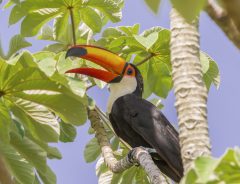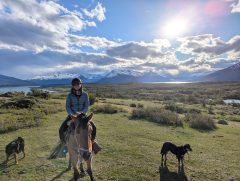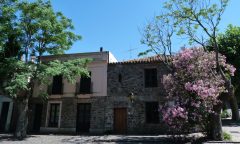Into the Amazon

The Amazon abounds with myths.
Misunderstood legends attracted the original explorers - Francisco de Orellana led the first expedition seduced by tales of El Dorado, returning with chronicles of encounters with the Amazonas, the mighty barechested female warriors. Followed over the centuries by pioneers in search of slaves, gold and oil, naturalists of the Enlightenment, rubber barons, cattle ranchers and loggers, all seeking to exploit the region for personal gain.
In the shade of massive trees and tangled vegetation, lianas and vines reach up to the canopy, strangling trees in their wake. Among the ferns, mosses, epiphytes and trees of medicinal qualities are walking palms and killer figs. Having never experienced an ice age the Amazon has had sixty million years to evolve this huge reservoir of biodiversity. Yet, with its ecology still virtually unexplored, there is a fear that this potential genetic library may be lost forever, ironically all in the name of 'progress and development'.
Although slightly shorter than the Nile by a few kilometres, the Amazon dwarfs every other comparison, its tributaries carrying approximately 20% of the world’s fresh water. From its source in the Peruvian Andes it travels over 6000 kilometres to its estuary, a delta so large that it holds an island (Marajó) the size of Denmark. At Santarém, over 800 kilometres inland, its banks are further apart than the distance from London to Paris.
Manaus, located as far from Rio as London is from Istanbul, is the Amazon’s commercial centre and the base for trips to ecological lodges. It is a scruffy but interesting town with a bustling waterfront and the faded remains of an opulent past. Fuelled by the USA’s expanding automobile industry of the late 19th Century, Manaus’s dalliance with wealth began. The magnificent rose-coloured, neo-classical opera house stands testament to a period when its artists and materials were imported from Europe and rubber was laid on the streets to absorb the clatter of horses’ hooves. Eiffel of Paris built the art nouveau roof over the Mercado Modelo and the floating docks that still cope with the 15-metre rise and fall of the river were constructed on the Clyde.
The success of the rubber boom in Manaus was soon to be punctured by the English botanist Henry Wickham who smuggled thousands of seeds out of the Amazon to be nurtured in Kew Gardens. The ‘stolen’ seedlings were later cultivated more efficiently in the large plantations of Ceylon and Malaya. Today, Manaus is a free trade zone where most of the televisions for this soap-opera-loving country are manufactured.
In common with much ‘modern’ thinking during the 1960s and 70s, the forest was regarded as a limitless resource, ripe for exploitation. The trans-Amazonian highway was built, huge projects such as hydroelectric dams were constructed and thousands of acres were cleared for cattle ranching. It was only in 1989 that the serious devastation was brought to international attention. For all its power and immensity, the Amazon needs protection, and by visiting the region, you are helping to do just that. Eco-tourism can provide the local government with a source of long-term and sustainable income that can benefit both the community and the forest.
A visit to this region is primarily about the rainforest and its wildlife. Jungle Lodges can be reached by boat, usually a few hours from Manaus, passing the ‘meeting of the waters’ en route, where the black waters of the Rio Negro and the murky brown water of the Rio Solimões flow adjacent without merging for several miles. These lodges buried in the jungle still offer you the opportunity of seeing the giant Victoria Regia waterlilies, pink river dolphins, iguanas, monkeys and toucans, while learning about the medicinal qualities of plants and trees, spot caimans at night, and if you are particularly lucky, catching a glimpse of an anaconda or jaguar.
By Karen Ward, former Journey Latin America Tour Leader.
Tailor-made holidays
Flexible, custom-made holidays to Latin America created to match your exact requirements: our tailor-made itineraries are as unique as the clients for whom they are designed.
Design my tripPapagaio
Your edit for Latin American inspiration
Our exciting range of articles on Latin America explore everything from iconic destinations and lesser-known cultural gems to delicious traditional recipes. You’ll also find exclusive travel tips, first-hand client reviews and the chance to get your personal questions answered by our travel experts.
View Extraordinary Inspiration






































